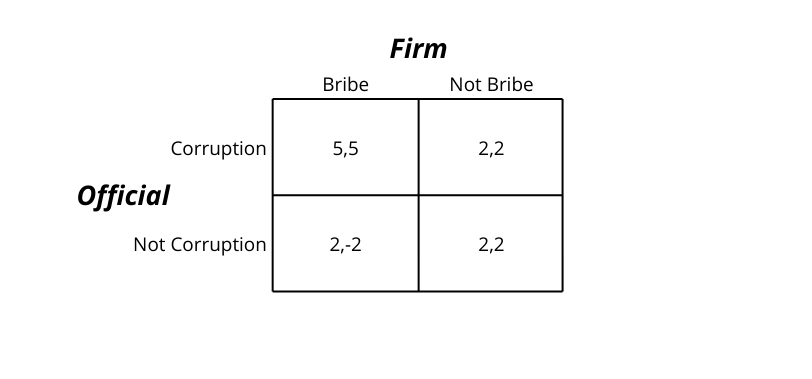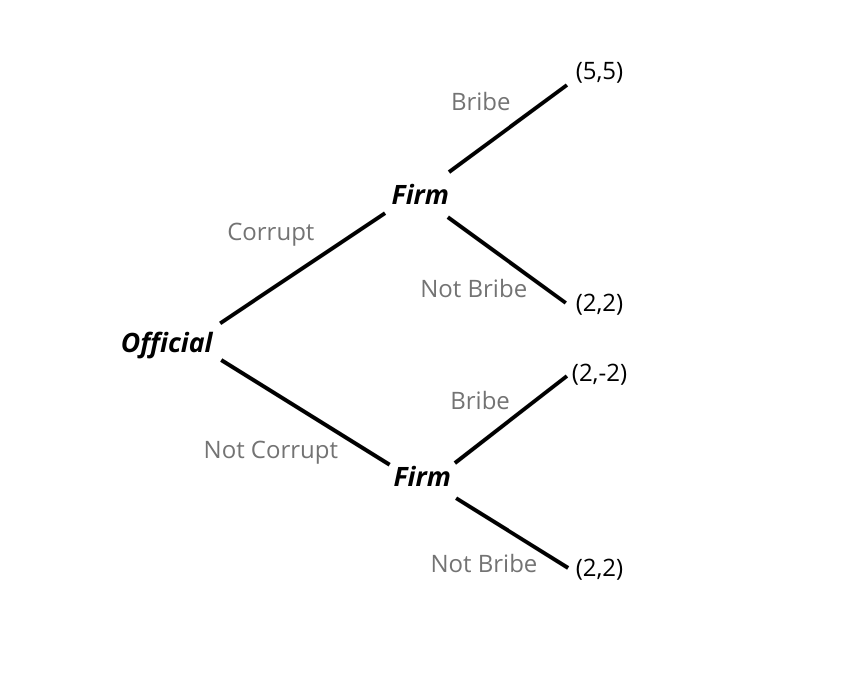
GAME THEORY

This project uses game theory to explore what drives corruption. Starting with a basic interaction between firms and regulatory officials, it shows how officials might exploit their power without checks. The study then advances to a sequential game to reveal how such dynamics lead to corruption. By introducing a government agent who can penalize corruption and implementing a signaling mechanism for honesty, the project examines different information scenarios. The aim is to align incentives with societal benefits, in order to provide insights from real-world examples to support the theoretical models.
by Mathieu Breier & Luis Francisco Alvarez Poli
December 12, 2023
Corruption constitutes an important obstacle for development, especially in developing countries. The International Monetary Fund estimated in 2019, that countries regarded as less corrupt tend to generate higher revenues. Specifically, governments with low corruption collect around 4 percent more of their GDP in taxes compared to nations with similar economic development but facing higher levels of corruption (Paolo Mauro (2019)). Empirical investigations by Pellegrini and Gerlagh (2006) similarly demonstrate a negative association between GDP growth rate and heightened corruption levels. Notably, richer countries, on average, exhibit lower corruption indices.
By proposing a simple interaction game between officials, firms and then, a governmental entity, we focus on identifying the incentives, as well as the fundamental assumptions in this build and the factors that could affect the outcomes. In our project, we aim to understand the rationality behind these type of behaviours, i.e. what justifies the decisions of rational agents to become corrupt. Our goal is, by making use of the model, to explain real-world dynamics on how agents make decisions but also on how they can be altered. We acknowledge that the model is simple and unrealistic, however we consider it can explain some behaviors observed, and we shall relate them to real life scenarios.
This study gathers inspiration from a diverse body of research delving into the modeling of corruption through a game theory approach.
Macrae (1982) adopts the basic assumption that corruption is a rational decision deeply rooted in individuals seeking a competitive advantage. He investigates the rationale behind an overseas corporation considering bribing a local official as part of an attempt to gain a contract. In the analysis, he finds that corruption exerts a negative impact on economic development and income redistribution. He advocates for more stringent legal sanctions and enhanced transparency as potential remedies to curb corruption.
Cerqueti and Coppier (2016) investigate the relationship between public corruption, environmental deterioration and the role of the state. They design a simple game with incomplete information, where the State attempts to control pollution through an emission tax rate. They introduce 3 players, a polluting firm (tax payer), an environmental inspector (tax inspector) and a politician that all have the choice to behave in a corrupt manner or comply with the law. Their model assumes that corruption may occur at different levels. Polluting firms have an incentive to corrupt in order to reduce the amount of environmental taxes it would have to pay. The level of emission of the polluting firms is determined randomly by the nature. What sets their model apart is the possibility that the polluting firm might not be checked by the tax inspector, whilst it is often taken as an assumption. They find that the state, for environmental protection, can either increase monitoring to reduce evasion and boost tax revenues or enhance compliance among polluting firms, resulting in lower evasion and greater tax revenues. Although this paper is on a specific issue within corruption as polluting; it is still relevant for our analysis due to the fact that the underlying dynamic, driving the behaviours is unchanged.
Zhu (2012) contributes to this discourse by employing game theory to investigate the ineffective mechanisms employed in China to combat corruption. Contrary to the assumption that increasing penalties alone will deter corruption, Zhu (2012) finds that it would instead reduce the frequency of investigations. This happens because corruption and investigation of corruption are part of an interactive process between two rational players instead of a one-sided decision process. Therefore, he argues that to make penalties effective in prevent- ing corruption, it is crucial to link the payoffs of the officials in charge of anti-corruption with corruption punishment, so as to promote anti-corruption incentives. Lowering the level of corruption also requires promoting incentives for investigators, such as rewarding anti-corruption monetarily or politically.
In his study, Zhu (2012) considers four assumptions in his game referring to potential behaviors that the players, a lower official and a party secretary, could potentially exhibit: Assumption 1: the investigator is honest and responsible, i.e. always investigates and punishes corruption. Assumption 2: The lower official is attracted to corruption. The payoffs of accepting corruption are higher for the official compared to refusing corruption. Assumption 3: Investigating an honest official by mistake is more costly. Assumption 4: The lower official punishes corruption. The punishment of corruption brings a cost to the lower official, hence the official has an incentive to be honest rather than corrupt. To examine how the political reality interacts with penalty designs, Zhu (2012) make a distinction between a tough party secretary who benefits from investigation corruption, and a soft party secretary who will have higher cost of investigating than benefits. In his theoretical game, only the party secretary knows its own type, constituting a game with imperfect information. We draw inspiration from Zhu (2012) rationality framework and Tsebelis’ Robinson Crusoe Fallacy (1989) to construct our game.
Tsebelis (1989) emphasizes, via identifying Nash equilibrium in six different scenarios, that the mixed strategy of both players is always an equilibrium regardless of whether the game has complete or incomplete information, simultaneous or sequential moves and discrete or continuous choices. In other words, the payoffs of neither the investigator nor the official depends on their own utilities but rather on a cooperation of the players. We incorporate his rationality into our sequential game.
The initial scenario consists of two set of agents, namely the officials and the firms. We characterize officials as employees who, on an individual basis, are responsible for enforcing regulations on the firms they oversee. The firms are defined as economic agents or organizations that aim to make revenue and profits.
In the context of our game, the players interact by deciding whether to corrupt/be corrupt or reject corruption. The firms gain a competitive advantage over the other firms if the officials take their bribe, which allows them to earn higher profits with the help of the officials. If they offer a bribe to an honest official, they will face a consequence. As for the officials, they will obtain a higher payoff in case they accept bribery and as a result earn more money. We define the action as bribing or not bribing for the firms and accept the corruption or reject the corruption for the officials.
We indicate each player’s payoffs in the figure below:

The highest payoff of 5 occurs when both players choose to be corrupt. When the firm doesn’t bribe, both the official and the firm get 2 as their payoffs, which corresponds to a stationary situation where nothing changes. If the firm bribes, its payoff will be 5 if the official accepts the bribe, and -2 if the official refuses the bribe and reports the firm. Finally, it is relevant to highlight that firms have no power to ’call out’ corrupt officials. This assumption makes the game imbalanced in terms of power; which is what we wanted to model.
To solve the game, we first fix the firm choice to bribing the official. In this situation the official would accept the corruption. Conversely, when the firm decides to not bribe, the official would be indifferent between being corrupt or not. To obtain the firm’s optimal choices, we first set the official choice on being corrupt and we observe that the firm’s response would be to bribe. In this situation where the official is not corrupt, the firm would have an incentive to not bribe as well.
As a result, we obtain 2 equilibria. The first equilibrium corresponds to the situation where both players decide to engage in corruption: (C,B), and the second to the situation where both players decide to not be corrupted at all (NC,NB).
This result indicates that there is a positive probability for a corrupt equilibrium, both players would like to mimic the other’s strategy and maximize their payoffs.
To understand the rationality behind corruption in a more accurate and realistic manner, we transform our static game into a sequential game where players choose their action after observing the other players decision. More specifically, we assume that the official has the possibility to play first by choosing whether to become a corrupted official or not. This way, we are internalizing the characteristic of corruption as a decision, i.e. as a function of the parameters of the model (assumptions). The firm will choose its action after observing the state of the official. This scenario gets closer to reality because firms wouldn’t typically act in a simultaneous way due to the fear of being reported. Instead, they would usually wait and observe whether the official leans towards more or less corruption.
The sequential game, with the same payoffs as in the initial game, is illustrated below in Figure 2:

In order to obtain the sequence of optimal actions in the game, we use the backward induction process. It is clear that the firm’s strategy is unchanged, it will mimic the official’s strategy. However, in this new scenario, the official can internalize how the firm will act and adjust his strategy accordingly. Therefore, with backwards induction, the official will compare the payoffs of both being honest to both being corrupt; choosing the later option. Both players will obtain a payoffs of 5 in this case. This model predicts that a corrupt equilibrium will be found every time, if nothing changes from this proposition.
This sequential games particularly emphasizes the clear incentive for the official to be corrupt given that corruption is for the official, so far, not associated to any sanctions.
In this final extension, we will introduce a new agent into the model, the government. Here we will remove the firms out of the equation. They become irrelevant in this new model, if we take into account that in the previous exercise the equilibrium was found at both players being corrupt. The firms cannot do anything to alter the officials behaviour. The government will then penalize the official if it considers him corrupt, by sending it to jail (J), although it cannot observe if the official is actually corrupt or not. We assume that the government has full power to decide which officials are sent to jail and which are not, even without any evidence. Its objective will be to minimize corruption, but without penalizing honest officials who indeed do not engage in corruption.
We can think of think of the following payoffs for the 4 possible resulting scenarios from this interaction in the form of: Payoffs = (O, G).
The payoffs for the official will remain unchanged from the previous exercise in case it doesn’t go to jail. The payoff for being charged for corruption will be equal to -2. On the other hand, the government will get its highest ”utility” when it is able to send a corrupt official to jail, and its lowest when it charges of crimes to officials who didn’t commit them.
Ideally for the government, in a world with perfect information where the behaviour of the official is observable, it would like to send to jail corrupt officials and not pursue (honest) officials which it knows for certain that they are honest. Then, all corrupt officials would be sent to jail and all the ones that are not corrupt would escape the punishment. This scenario does not provide any insightful information, but will help us to visualize how does the government will try to align the incentives. We will now move from this perfect information scenario, and model a signalling game where the government tries to identify the officials by the signal they choose to provide.
Consider a signaling game between the government (G) and officials (O). There are two types of officials: Honest (HO) and Dishonest (DO). The government cannot observe the official type but will receive a signal (or no signal) from the officials and make his strategy upon it.
We can think of the signal as a legitimate certification, or some valid record that verifies the proper behaviour of the official. To get hold of this certificate, the officials need to work hard (and properly), incurring in a cost. Including the time and financial investment required to acquire the necessary skills, attend courses, and pass examinations and reject potential bribes. Dishonest individuals may incur a higher cost by engaging in fraudulent activities to obtain fake certifications, forging documents, or misrepresenting their qualifications. This higher cost includes the risk of legal actions, potential job loss if discovered, and damage to their professional reputation.
We can have 3 different types of equilibria. In a separating equilibrium, Honest officials signal (S), while Dishonest officials do not signal (NS). In a pooling equilibrium, both Honest and Dishonest officials either both signal (S) or both do not signal (NS). The three considered cases will be:
Now let’s think about the payoffs in each scenario, and which assumptions would be necessary for each one. We will start with the separating equilibrium.
Reward − C(S|HO) = 3 − 3 = 0
While DO will face:
Reward − C(S|DO) = 3 − 6 = −3
Both of them will compare these payoffs with the expected one without signaling:
No Reward − C(NS) − J = 0 − 2 = −2
It is clear that no official has an incentive to deviate from their strategies. If either one changes their strategy, he will clearly be worse off.
If we now change the parameters (Costs/Rewards) we can obtain a set of equilibria where all officials play the same strategy. For example, in the case where Rewards are now 1 instead of 3, payoffs for (HO,DO) = (-2,-5). Thus both can choose to offer no signal and they would be at least as well as by playing the signal. This equilibrium is not useful for the government. On the other hand, if the Reward is too high (or cost too low), we could see both players signalling; hence DO deceiving the government into thinking they are HO. This is also useless for the government objective.
Pooling vs. Separating will depend on the relationship between the cost of signalling, the punishment of going to jail and the reward the government might provide after observing the positive signal. More specifically the critical values will be:
We will have a separating equilibrium if: R ≤ C(DO) − J & R ≥ C(HO) − J
We will have a pooling equilibrium if: R ≥ C(DO) − J or R ≤ C(HO) − J
The government will try to manipulate this values in order to reach a separating equilibrium and correctly identify the types of officials.
The model we built could serve to better understand the underlying incentives and rationality driving corruption which ultimately provides key insights on how to counteract corrupt practices, for instance within the context of high-polluting firms. The unfortunate reality in numerous transitional economies involves firms resorting to illegal ways to avoid emission reduction and associated costs. High-pollution companies may attempt to influence local governments through lobbying or bribery to secure political protection (Huihua and Li (2013) & Fredriksson and Neumayer (2016)) or sidestep stringent environmental regulations (Biswas et al. (2012)). This underlines the importance of third-party regulations, starting by understanding the rationality behind corruption. As illustrated in our analysis, the key focus should be on identifying effective and relevant incentives that discourage officials from accepting bribes and instead encourage frequent investigations. The applicability of our model extends beyond the examined scenario, offering insights into corruption-related issues, incentives, and rationality.
As we conclude our exploration of the topic, we can mention a few key findings. If there is an unbalanced weight in terms of power, there is room for the abuse of the better positioned player to dictate the behaviour of the other one. In our first case, the official will decide whether to engage in corruption or not, and the firm will simply follow this strategy. When we tackle this decision, we show that there are mechanisms that, if properly implemented (assumptions/parameters) properly, can help to identify these corrupt agents. A governmental entity will play a big role in this interaction. We believe our model is very simple but powerful because it illustrates a behaviour that could be applied logically in many instances outside of our basic example.
Modelling Corruption using a Game Theory Approach
The Github repository: https://github.com/mtbrr26
You can contact me through my email: mathieu.breier@bse.eu
You can download my CV here
Follow me on these social media platforms:
Github: https://github.com/mtbrr26
LinkedIn: https://www.linkedin.com/in/mathieu-breier/
© Mathieu Breier